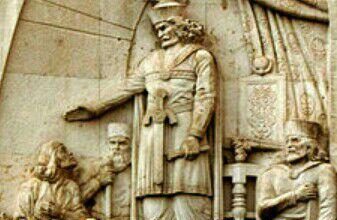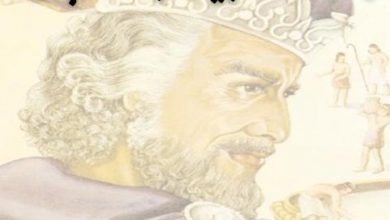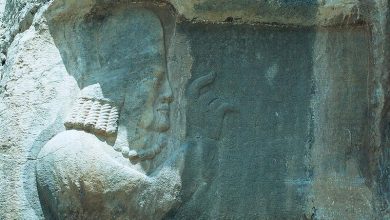The Sassanid army is the eternal honor of Iran
The elite of the Sassanid army As in the Parthian period, it was an armored and heavy-armed cavalry consisting of purebred horsemen. Cavalry ( the horsemen ) He had the first position in the battle line and conquest and victory depended on their strength and courage.
The imperial government of Ardeshir I expanded under the protection of a decorated and powerful army. Undoubtedly, vague memories of the greatness of the Achaemenid Empire still remained in the mind ? It did not remain unaffected in the politics of this emperor.
This policy consisted of: Renewal of the imperial government of the East ? which was destroyed by the cursed Alexander ( Herodianus ). As we know, the Parthians also made efforts to renew the greatness and power of the Achaemenids, but they were not completely successful. Therefore, in the policy of Ardeshir and his first successors, the will of Jahangiri and the plan of the imperial government are hidden in favor of this opinion.. Another opinion was to protect the northern, eastern and western borders from the encroachment of the enemies, and since these borders were constantly exposed to attacks and threats from the neighbors, the Sassanids inevitably needed a strong army to fulfill this purpose..
Ammianus, a Greek cavalry officer of the Roman army, who was born in the city of Antioch in Syria ? He has witnessed this terrible army closely. He participated with Roman Emperor Julian in the war with Iran during the Sassanid reign of Shapur II, and after the defeat and death of Julian, he returned to Rome with the remnants of the Roman army and began to map the history of Rome 13 and quit military service.. He led the Iranian army in the vast plains of Rhodan ( Mesopotamia ) This is how he describes it :
The Iranians sent regular troops of armored cavalry against the Romans with such massive processions ? that the eyes of the enemies were dazzled by the light of their armor and weapons. The cavalry was like a unified iron. The body of the people was covered with iron plates and this iron stuck to the body so that the dry joints of the armor easily followed the movements of the body parts.. To protect the face, they put a mask on the face and therefore no arrow could hit the body except in the small holes that were built in front of the eyes and the narrow slits that were built under the nostrils and from there they breathed with great difficulty.. Some of them are holding a spear ? They stood motionless in one place ? As you said, they are connected by iron chains. Next to them, the archers were stretching their hands and stringing their bows ? In such a way that the string touches the right side of the chest and the arrow of the arrow connects to the left hand. Due to skillful finger pressure ? He was looking for an arrow, and it made a roar and inflicted a terrible injury.
He says elsewhere :
The Iranians could not stand being defeated in the war ? Because they were only used to fighting bravely from a distance and if they realized that their forces had begun to retreat ? They retreated like a storm cloud, and since they were shooting from behind, the enemy could not pursue them.
He goes on to say:
Iranians trusted Sawar Nizam more than other parts ? Because in that guild, all nobles and nobles performed very difficult services.
As it was customary in the Achaemenid era, in the Sassanid period, a delegation of selected horsemen was formed. ” Board of Immortals ” It was called that it was composed of ten thousand people and its commander was nicknamed Werthargenigan Khodai. Next to this unit ? There is another unit that conveys courage and fearlessness from death ” Name Gian Ospar ” ( John Spar ) have been read.
Behind the head of the cavalry ? Elephants were placed. Their screams, smell, and terrifying sight frighten the enemy's horses. Pilbanan sits on their backs ? Each of them held long-handled knives in their right hands ? so that sometimes an elephant gets scared by the attack of the enemy and falls in the ranks of the army and throws the soldiers to the ground and tramples them. ? Pilbanan plunged the knife into the vertebrae of the back of the animal's neck and removed it from its leg.
At the end of the infantry corps ( Pagan ) It was supposed that their commander was called Paigan Salar. Infantrymen were armed with shields, spears and helmets like the Roman Mirmilos and served behind the front. These infantrymen were ordinary villagers whose duty was to serve the army, and they went to war without any hope of pay or reward.. Some of this group had long curved shields ? which was made of straw and a skin was put on it. In general, it should be said that these soldiers were not good.
Along with these units, there are always units sent from other kings subordinate to the Iranian Empire, such as the Caucasus Mountains and the south of the Caspian Sea, including the Giles, the Cadusians, the Verts, the Albanians, the Dilmians, the Armenian cavalry, and the Scythian soldiers. ( Sistani ) In the meantime, like the Achaemenid period, the Scythians were the best helpers of the Iranian army.
The large units of the Corps were called Gands and their command was with Gandsalars. The smaller divisions were called darfash and the smaller ones were called vasht..






